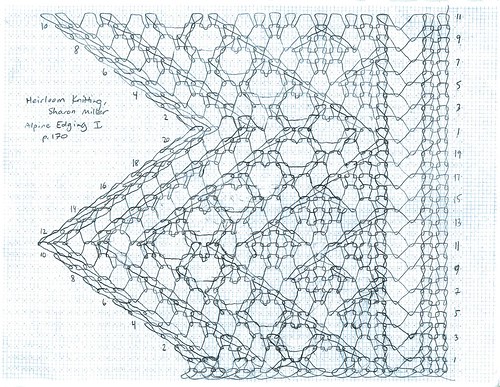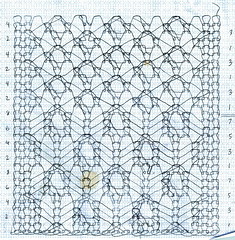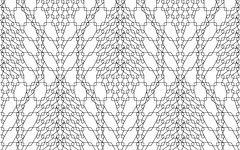 I posted recently some diagrams I made of Barbara Walker's "Day-flower" lace insertion pattern found in one of her Treasuries stitch collection books.
I posted recently some diagrams I made of Barbara Walker's "Day-flower" lace insertion pattern found in one of her Treasuries stitch collection books.It took a lot of practice and exploration for me to be able to do that latest, most detailed diagram.
About two years ago I was trying to figure out how to illustrate knitting stitch patterns in the old-school way, where it's all hand-drawn, showing each twist and turn of the knitted yarn. I did develop one method, shown here, that's most suitable for lace knitting, and even for knitted lace, where the shaping is done on each row.
There's a whole lot of idealizing and simplifying involved, but this kind of illustration is at least "topologically" accurate.
The key for me was designing and printing a type of graph paper that represents the approximate 3:4 height-to-width ratio of knitted stitches. Then I had to figure out the rather weird things that yarn overs do to the proportions of the knitted loops.
These illustrations show how an ideal knitted fabric would look when projected on a screen, that is, all of the three-dimensional quality of the fabric is lost. There's no information here about whether stitches are knits or purls nor whether the decreases are right- or left-leaning, only where the yarn overs and decreases are, and how the columns (wales) of stitches slant and flow into each other.
Still, they are much more faithful to the look of the knitted fabric than anything I'd been able to do up to that point. I could even knit from them, but I'm weird that way.
Eventually I started to do this on a computer, like the third illustration here. Still, I like the hand drawn ones because of the roughness. You'll see more examples of this kind of diagram in my Flickr set "Knitting Diagrams."






![Reblog this post [with Zemanta]](http://img.zemanta.com/reblog_e.png?x-id=3bb82b3a-3e52-4553-aca7-b76e2047fc5e)
No comments:
Post a Comment